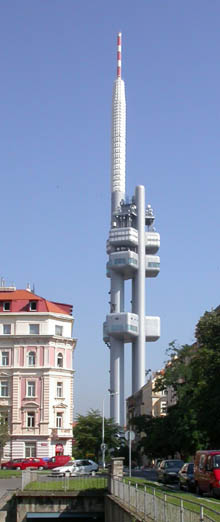
<p>The tower would not be built differently today, says high-tech enthusiast Aulický.</p>
Source
Markéta Horešovská
Markéta Horešovská
Publisher
ČTK
03.03.2019 09:15
ČTK
03.03.2019 09:15
Czech Republic
Prague
Žižkov
Václav Aulický
 |
Although he has many other buildings behind him, including the most famous transmitter, he is most often talked about today in connection with Transgas. The state refused to protect the complex of buildings as a monument, and its current owner has begun its demolition. Aulický today refers to Transgas as his child; he got to its construction accidentally, he says.
"When Ringo Starr was asked how he got to the Beatles, he said: I didn't do anything for it, just when it came around, I said 'yes'. Because circumstances and coincidences play a significant role in life," says the architect when asked whether he intentionally chose buildings that ideologically did not succumb to the party's approval processes. One circumstance that positively influenced him in life was meeting his later wife, whom he married while still studying. She is also an architect, and they are still together. Therefore, after school, as the mandatory military service approached, he joined the Military Project Institute.
"I found out that with a little luck, they would take you back to design during the military. I was sent to Trutnov, and within a few weeks I received orders to work in Prague as a soldier designer," he recalls. Back then, he tried not to provoke too much so that he wouldn't have to serve "hard" and far from home. He participated in competitions and achieved his first successes.
And when the transit gas pipeline from the Soviet Union to Czechoslovakia began to be planned, VPÚ connected with Plynoprojekt, where architects Jindřich Malátek and Ivo Loos had already won a competition for the gas dispatching center. "A circumstance brought us together, and we started working on the transit gas pipeline project." Just like in communication buildings, it was not primarily about those buildings; it was a fraction of the investment compared to constructing the gas pipeline.
"Thus, the transit gas pipeline complex was born, which is considered by experts to be a transition between brutalism and high-tech and is now being demolished... Maybe someone will buy it who won't want to demolish it. But for me, the hope is very small," says the architect, who is closely watching the fate of the building. He is pleased with the interest in it, especially from young people.
However, Aulický is a strong supporter of technological development and understands that an economically minded and ambitious investor does not want a building that does not meet current standards and does not suit his plans. Buildings with one clear function, after losing it, must seek a new purpose and also replace all outdated technologies.
"The Žižkov Tower was not built to be big or have a lookout, but to broadcast. If today someone replaced its function with something else, what would it be for?" asks its author self-critically. He recalls that television broadcasting is only a partial function of the tower; a larger part is used for transmitting radio stations on very short waves or mobile phone network signals. The authors had already foresightedly counted on this. "We knew that radiotelephones would come; after all, some information did come to us from the West," Aulický laughs.
If some people label the transmitter or Transgas as high-tech architecture, Aulický perceives the ISS station in orbit as the greatest example of high-tech. "Its authors have to ensure that around five people can live, eat, sleep, and go to the bathroom in space for up to two years, solving everything that every architect deals with for every building - but additionally in a vacuum," says the creator, who describes himself as afflicted by civilization. "I support civilization; I think civilization is not a malignant tumor; I believe people have gained reason to move forward. They may sometimes hit each other, but they move forward, and when there is trouble, they will help one another. And one day there will be cities on Mars, that's for sure," he reflects.
The English translation is powered by AI tool. Switch to Czech to view the original text source.
5 comments
add comment
Subject
Author
Date
hig-tech trojpyj do Vinohrad
Švec O.
03.03.19 03:33
Hm
Josef Brofský
03.03.19 04:33
Jak že zní ta definice?...
šakal
03.03.19 05:34
na obranu trojpyje
Josef Citovský
03.03.19 06:33
na obranu trojpyje
Dr.Lusciniol
04.03.19 11:08
show all comments
Related articles
0
15.07.2020 | The architect Aulický wrote a book about the Žižkov Tower
10
16.02.2012 | The Žižkov TV Tower has been towering over the metropolis for 20 years
39
20.11.2009 | The Žižkov Television Tower is the second ugliest building in the world
0
21.11.2005 | People have gotten used to the initially rejected tower over 20 years












